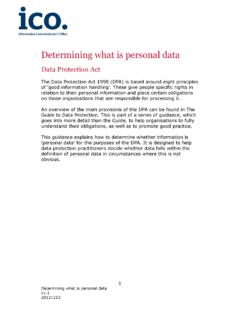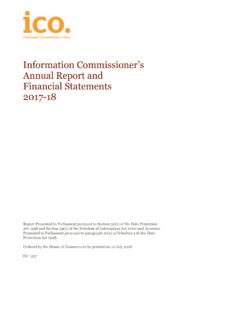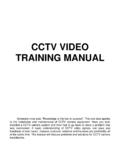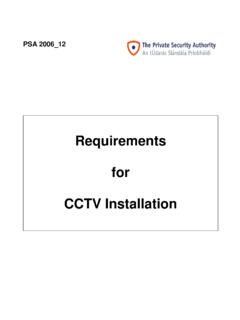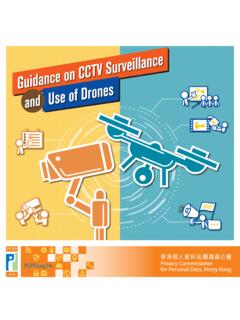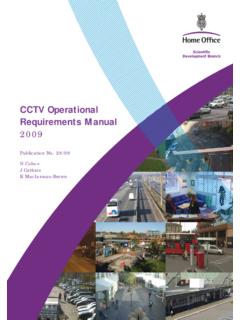Transcription of CCTV code of practice - Home | ICO
1 Data protection In the picture: A data protection code of practice for surveillance cameras and personal information Version 1. 20170609. Please note: The following information has not been updated since the Data Protection Act 2018 became law. Although there may be some subtle differences between the guidance in this document and guidance reflecting the new law we still consider the information useful to those in the media. This guidance will be updated soon to reflect the changes Contents Introduction .. 3. About this code .. 4. What this code covers .. 6. Deciding when surveillance camera systems should be used .. 8. Governance.
2 10. Selecting and siting surveillance 24. Surveillance technologies other than cctv systems .. 25. Using the equipment .. 34. Responsibilities .. 37. Appendix 1 .. 40. Appendix 2 .. 41. Appendix 3 .. 43. Version 2. 20170609. 1. Introduction The Information Commissioner's Office (ICO) issued its first code of practice under the Data Protection Act 1998 (DPA) covering the use of cctv in 2000. The code was developed to explain the legal requirements operators of surveillance cameras were required to meet under the Act and promote best practice . The code also addressed the inconsistent standards adopted across different sectors at that time and the growing public concern caused by the increasing use of cctv and other types of surveillance cameras.
3 A lot has changed since this time and, while the original code was updated in 2008, further legal, practical and technological developments mean that updated guidance is required. We have moved away from cctv simply being a camera on top of a pole in our local town centre where the images were recorded on to video tapes, to much more sophisticated operations using digital and increasingly portable technology. The use of Automatic Number Plate Recognition (ANPR) is now commonplace and body worn cameras are being routinely used by organisations, such as the police. Surveillance cameras are no longer a passive technology that only records and retains images, but is now a proactive one that can be used to identify people of interest and keep detailed records of people's activities, such as with ANPR cameras.
4 The use of surveillance cameras in this way has aroused public concern due to the technology no longer being used solely to keep people and their property safe, but increasingly being used to collect evidence to inform other decisions, such as the eligibility of a child to attend a school in a particular area. The unwarranted use of cctv and other forms of surveillance cameras has led to a strengthening of the regulatory landscape through the passing of the Protection of Freedoms Act (POFA). The POFA has seen the introduction of a new surveillance camera code issued by the Secretary of State since June 2013 and the appointment of a Surveillance Camera Commissioner to promote the code and review its operation and impact.
5 The ICO has contributed to this tougher regulatory landscape by taking enforcement action to restrict the unwarranted and excessive use of increasingly powerful and affordable surveillance technologies. While the title of this code has changed to highlight its focus on the data protection implications of using cctv and other forms of surveillance cameras, its objectives remain the same. The ICO has developed this Version 3. 20170609. code following extensive consultation. It is designed to help those who use surveillance cameras to collect personal data to stay within the law. 2. About this code This code provides good practice advice for those involved in operating cctv and other surveillance camera devices that view or record individuals, and covers other information that relates to individuals, for example vehicle registration marks captured by ANPR equipment.
6 This code uses the terms surveillance system(s)', cctv ' and information'. throughout for ease of reference. Information held by organisations that is about individuals is covered by the DPA and the guidance in this code will help organisations comply with these legal obligations. The DPA not only creates obligations for organisations, it also gives individuals rights, such as the right to access their personal information, and to claim compensation when they suffer damage The basic legal requirement is to comply with the DPA itself. This code sets out the Information Commissioner's recommendations on how the legal requirements of the DPA can be met.
7 Organisations may use alternative methods to meet these requirements, but if they do nothing they risk breaking the law. This code also reflects the wider regulatory environment. When using, or intending to use surveillance systems, many organisations also need to consider their obligations in relation to the Freedom of Information Act 2000 (FOIA), the POFA, the Human Rights Act 1998 (HRA) and the Surveillance Camera code of practice issued under the Protection of Freedoms Act (POFA code ). The POFA in particular has an important role in regulating surveillance systems, creating the role of the Surveillance Camera Commissioner, which the Information Commissioner has a memorandum of understanding with to ensure effective cooperation.
8 The Surveillance Camera Commissioner is charged with promoting good practice regarding surveillance cameras and to encourage compliance with the POFA code . The POFA code is also an important document to refer to when your issue is not a data protection one. It provides advice and guidance on issues such as operational requirements, technical standards and the effectiveness of the systems available. The 12 guiding principles are the Version 4. 20170609. key component of the POFA code and these are referenced throughout the ICO code to enable practitioners to see the core compliance points in both codes. The guiding principles in the POFA code are also contained in annex 3.
9 This code is consistent with the POFA code and therefore following the guidance contained in this document will also help you comply with that code . The POFA code explains that it: provides guidance on the appropriate and effective use of surveillance camera systems by relevant authorities '. The POFA requires relevant authorities to have regard to guidance in the POFA code . In general terms, the police, police and crime commissioners and local authorities in England and Wales are designated as relevant authorities, along with the National Crime Agency. All other data controllers are encouraged to follow the POFA code and advice from the Surveillance Camera Commissioner as good practice .
10 This code outlines the connections it has with the POFA code to help you comply with both. Further details can be found on the Surveillance Camera Commissioner's website. Unlike the DPA, the POFA only applies to England and Wales and therefore is not applicable to the rest of the UK. The Scottish Government has produced its cctv Strategy for Scotland. The strategy provides a common set of principles that operators of public space cctv systems in Scotland must follow. The principles aim to ensure that these systems are operated fairly and lawfully and are using technologies compatible with the DPA. This code of practice covers a wider area than the POFA code .
